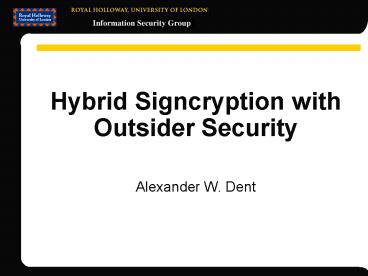Hybrid Signcryption with Outsider Security - PowerPoint PPT Presentation
Title:
Hybrid Signcryption with Outsider Security
Description:
Hybrid encryption ... Hybrid signcryption ... It's easy to build efficient, provably secure hybrid signcryption schemes. ... – PowerPoint PPT presentation
Number of Views:33
Avg rating:3.0/5.0
Title: Hybrid Signcryption with Outsider Security
1
Hybrid Signcryption with Outsider Security
- Alexander W. Dent
2
Signcryption
- Introduced by Zheng 1997.
- Combines advantages of PKE and signatures
- Confidentiality
- Integrity/Origin authentication
- Non-repudiation?
- A relatively new type of primitive.
- We havent even agreed a security model yet.
3
Signcryption
- A common parameter generation algorithm.
- A receiver key-pair (pkR,skR) generation
algorithm. - A sender key-pair (pkS,skS) generation algorithm.
- A generation-encryption algorithm.
- A verification-decryption algorithm.
4
Signcryption
- An, Dodis and Rabin (2002) security model.
- This is a two user model.
- Outsider security
- Security against all third parties, i.e. anyone
who isnt the sender or receiver. - Insider security
- Full security, including integrity protection
against attacks made by the receiver. - Baek, Steinfeld and Zheng (2002) model.
5
Signcryption confidentiality
- No third party can distinguish between a
signcryption of one message and a signcryption of
another message. - Normal IND criteria, except that we must provide
the attacker with encryption and decryption
oracles. - We do not consider forward security (with can be
expressed using the Baek et al. model).
6
Signcryption integrity
- An outside attack is one in which a third party
attempts to forge a signcryption from the sender
to the receiver. - Normal existential unforgeability game, except
that the attacker has access to encryption and
decryption oracles. - It has a similar security guarantee to a MAC.
- This is satisfactory for most applications (but
gives simpler schemes).
7
Signcryption non-repudiation
- The ability for a third party to check that a
given signcryption is a proper signcryption of a
given message. - Not required for most applications.
- Schemes which are outsider secure can never
provide non-repudiation. - Most signcryption schemes cheat and use NIZK
proofs.
8
Hybrid encryption
- Involves the use of black-box symmetric
algorithms with certain security properties. - Very popular trick
- ECIES/DHAES
- Fujisaki-Okamoto and related transforms.
- Most use the same trick of encrypting a random
symmetric key with the asymmetric algorithm. - Formalised by Cramer and Shoup (2004).
9
Hybrid encryption
KEM
pk
C1
Provides the confidentiality service (against
active attackers).
Controls the security service by generating
random symmetric keys.
K
DEM
m
C2
10
Hybrid signcryption
KEM
pk
C1
K
DEM
m
C2
11
Hybrid signcryption
KEM
pkR
C1
skS
K
DEM
m
C2
12
Hybrid signcryption
C1
KEM
pkS
skR
K
DEM
m
C2
13
Hybrid signcryption confidentiality
IND security as a KEM Given an encapsulation, it
should be impossible to tell the difference
between the real key and a completely random one.
KEM
pkR
C1
skS
IND security as a DEM It should be able to
resist active attacks against its confidentiality
(when used with a random key).
K
DEM
m
C2
14
Hybrid signcryption integrity
LoR security for a KEM It must be impossible to
distinguish the real KEM from an ideal version,
in which every valid encapsulation is associated
with a completely randomly generated key.
C1
INT security for a DEM It should be impossible
to forge a ciphertext that decrypts to give a
message (using a random key).
KEM
pkS
skR
K
DEM
m
C2
All practical (encryption) DEMs are INT and IND
secure!
15
Hybrid signcryption
- Very easy to bolt on outsider secure hybrid
signcryption to hybrid encryption schemes. - The paper contains a practical signcryption KEM
which we call ECISS-KEM - Encryption One exponentiation (and one
pre-computed group exponentiation). - Decryption One group multiplication (and one
pre-computed group exponentiation).
16
Hybrid signcryption
- The attacker finds a valid signcryption (C1,C2).
- Recovers the key K associated with C1.
- Computes C2DEMK(m).
- (C1,C2) is a forgery.
C1
KEM
pkS
skR
There must be a binding between the message m,
the encapsulation C1 and the symmetric key K.
K
DEM
m
C2
17
Key agreement using KEMs
- KEMs and key agreement mechanisms have a lot in
common... - ...but KEMs can only be thought of as the most
basic method of agreeing a key. - No authentication or freshness guarantees.
- Signcryption KEMs go part of the way to solving
this problem by allowing the users to
authenticate each other.
18
Key agreement using KEMs
- Alice uses a signcryption KEM to compute a (K,C)
pair. - Use the key K to compute the MAC of a timestamp
t. - Sends (C,t,MAC) to Bob.
- Bob checks the timestamp t is current.
- Recovers the key K using the signcryption KEM.
- Checks the authenticity of the MAC on the
timestamp.
Vulnerable to a known-key attack!
19
Insider security
- A paper appeared in ACISP 2005 describing a
construction paradigm for a hybrid signcryption
scheme with insider security. - A paper is currently being prepared which
improves on this result using tag-KEMs. - This also allows us to build key agreement
mechanisms.
20
Open problems
- Can we use this framework to develop new schemes?
21
Open problems
- No satisfactory model for multi-user security.
- Multi-user model should allow the attacker to
initiate users, replace public keys?, corrupt
users, make test queries, force users to encrypt
messages, force users to decrypt signcryptions. - Similar to Certificateless PKE security model.
- Should be easy for outsider security!
22
Conclusions
- Signcryption schemes are easy to build if we
recognise that outsider security is all that is
required for a lot of applications. - Its easy to build efficient, provably secure
hybrid signcryption schemes. - However, more work can be done in this
particularly under-researched area.































